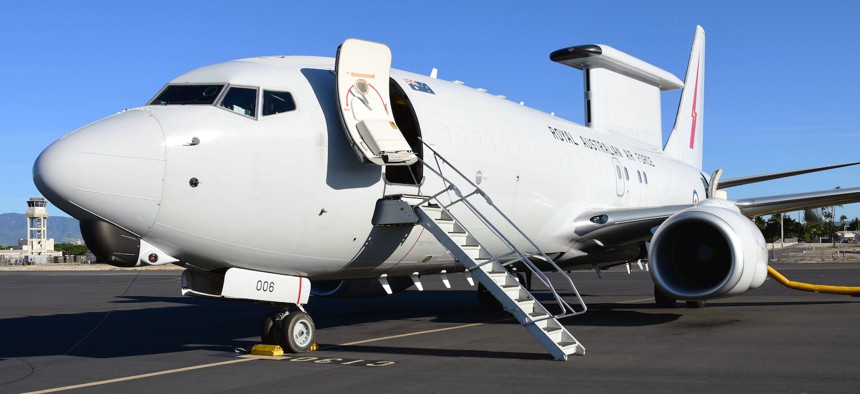
An Australian E-7 Wedgetail aircraft sits on the flight line on Joint Base Pearl Harbor-Hickam, Hawaii, April 16, 2021. U.S. Air Force / Tech. Sgt. Jimmie D. Pike
'Unexpected’ engineering slows price negotiations on USAF radar plane
Air Force officials thought the E-7 would more closely resemble UK’s Wedgetails.
AURORA, Colorado—A "unexpected" amount of engineering has the Air Force struggling to reach agreement with Boeing on a price tag for the E-7 Wedgetail radar plane, service officials said.
“We're having a hard time with that one getting a price agreement with Boeing. We're still in negotiations with them and that's not been finalized yet,” Air Force Secretary Frank Kendall told reporters Tuesday at the Air & Space Forces Association Warfare Symposium here.
Negotiations are being held up for the first two test E-7s because there was an “unexpected” amount of “nonrecurring engineering,” which is a one-off cost to develop a new platform, required to meet the Air Force’s needs for the program, according to Andrew Hunter, the service’s acquisition chief.
Service officials thought their requirements were close to the E-7s that the U.K. has already begun procuring from Boeing, Hunter told reporters here.
“Those discussions have been challenging and we're trying to get in to learn [and] understand the specificity of what's kind of implied in the Boeing proposal,” he said.
Hunter said Boeing has previously agreed to contacts without knowing “key information” about what would be required of them. Over the years, the company has taken billions of dollars in losses after agreeing to fixed-price contracts.
“Maybe at some level, it's not that surprising that they're trying hard to do their homework and not bid things and not understand the full scope of the work that they’re going to be expected to perform when they prepare their proposal,” Hunter said.
Asked about difficulties in reaching an agreement on E-7, a Boeing spokesperson said, “We’re partnering with the U.S. Air Force to deliver this critical capability and are working diligently to reach an agreement.”
This isn’t the first time the Air Force and Boeing have struggled to reach a contract agreement. Last year, Boeing was eliminated from the competition to build the Air Force’s E-4B “Doomsday” plane replacement because they couldn’t agree on contract terms or data rights.
Hunter said he hopes they will be able to “turn the wheel a little faster” on the bid and proposal process.
In February, the Air Force ordered two test E-7s from Boeing, which the company aims to deliver in 2027. The service wants to buy 26 of the radar planes.
The Pentagon has already given Boeing a $1.2 billion contract to jump-start E-7 development because officials say they need E-7s in the Indo-Pacific to handle airborne domain awareness and to maintain air superiority as the service begins retiring its old E-3 Sentry AWACS-carrying radar planes. Lawmakers have also been pushing the service to speed up E-7 production, and has questioned the service on why it can’t be sped up when Australia has already been flying E-7s for years.
